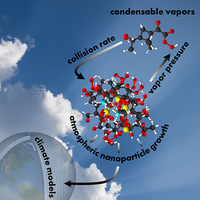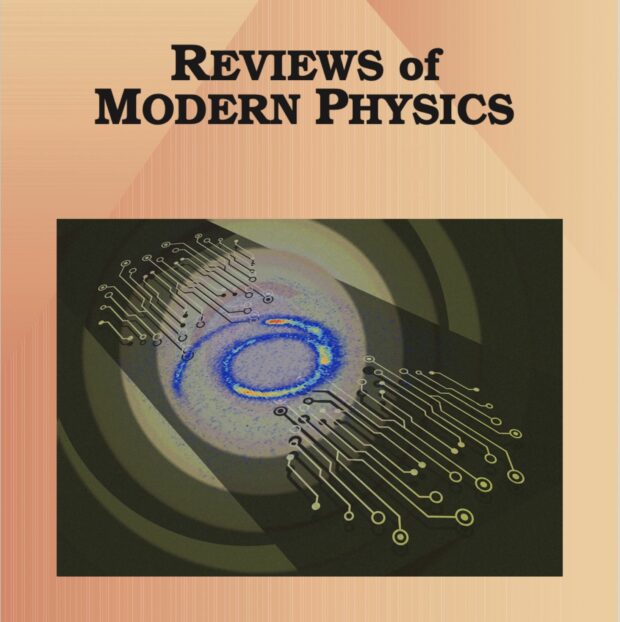大气纳米颗粒生长
IF 44.8
1区 物理与天体物理
Q1 PHYSICS, MULTIDISCIPLINARY
引用次数: 3
摘要
由气相前体形成液体或固体纳米颗粒的新颗粒是地球大气层中的一个决定性过程,被认为是气候变化预测中最大的不确定性之一。新粒子形成与气候相关性的关键是新形成的分子团的生长,因为它决定了这些粒子在云凝结核大小上的生存,在那里它们可以促进气溶胶的间接效应。这篇综述列出了纳米颗粒生长的基本定义,并阐述了新颗粒形成研究的快速新兴领域,重点是促进纳米颗粒生长过程的多样性,明确比较了最新的实验结果及其在大规模模型中的实施。大气中纳米颗粒的生长是一种复杂的现象,包括冷凝和反应性蒸汽吸收、气溶胶凝结和汇过程。它与热力学、团簇和相变物理学有关。根据颗粒尺寸分布的演变测量的纳米粒子生长速率将生长描述为一种集体现象,而模型通常在单个颗粒水平上对其进行解释,并将其纳入高度简化的尺寸分布表示中。最近的大气观测表明,硫酸与氨和胺、碘酸和氧化的有机物质一起可以促进纳米颗粒的生长,而大多数模型描述了这种可冷凝蒸汽的有限子集的生长效应。大气模拟室实验已经阐明了离子的作用、分子间作用力、酸和碱的相互作用以及不同类型有机蒸汽的贡献。特别是在有机蒸汽冷凝的复杂热力学方面,该领域在过去十年中取得了显著进展。虽然实验领域在方法和过程层面的理解方面取得了重大进展,但这并没有导致在大规模模型中对纳米颗粒形成的气候影响的描述有类似的改进。这篇综述为更好地协调纳米颗粒生长的实验和建模研究奠定了基础,为未来的研究提供了具体指导,这些研究旨在解决以下问题:为什么大规模模型中的气候反应似乎对高生存概率起到了缓冲作用,以及为什么本文中的全球增长观测结果显示出惊人的低变化。本文章由计算机程序翻译,如有差异,请以英文原文为准。

Atmospheric nanoparticle growth
New particle formation of liquid or solid nanoparticles from gas-phase precursors is a decisive process in Earth’s atmosphere and is considered one of the largest uncertainties in climate change predictions. Key for the climate relevance of new particle formation is the growth of freshly formed molecular clusters, as it determines the survival of these particles to cloud condensation nuclei sizes, where they can contribute to the aerosol-indirect effect. This review lays out the fundamental definitions of nanoparticle growth and addresses the rapidly emerging field of new particle formation studies with a focus on the diverse processes contributing to nanoparticle growth, explicitly comparing the latest experimental findings and their implementation in large-scale models. Atmospheric nanoparticle growth is a complex phenomenon including condensational and reactive vapor uptake, aerosol coagulation, and sink processes. It is linked to thermodynamics, cluster- and phase-transition physics. Nanoparticle growth rates measured from the evolution of the particle-size distribution describe growth as a collective phenomenon, while models often interpret them on a single-particle level and incorporate it into highly simplified size-distribution representations. Recent atmospheric observations show that sulfuric acid together with ammonia and amines, iodic acid, and oxidized organic species can contribute to nanoparticle growth, whereas most models describe the growth effects from a limited subset of this variety of condensable vapors. Atmospheric simulation chamber experiments have clarified the role of ions, intermolecular forces, the interplay of acids and bases, and the contribution of different types of organic vapors. Especially in the complex thermodynamics of organic vapor condensation, the field has had noteworthy advances over the last decade. While the experimental field has achieved significant progress in methodology and process level understanding, this has not led to a similar improvement in the description of the climate impact of nanoparticle formation in large-scale models. This review sets the basis to better align experimental and modeling studies on nanoparticle growth, giving specific guidance for future studies aiming to resolve the questions as to why the climate response in large-scale models seems to be buffered against high survival probabilities and why the global growth observations herein show surprisingly low variation.
求助全文
通过发布文献求助,成功后即可免费获取论文全文。
去求助
来源期刊

Reviews of Modern Physics
物理-物理:综合
CiteScore
76.20
自引率
0.70%
发文量
30
期刊介绍:
Reviews of Modern Physics (RMP) stands as the world's foremost physics review journal and is the most extensively cited publication within the Physical Review collection. Authored by leading international researchers, RMP's comprehensive essays offer exceptional coverage of a topic, providing context and background for contemporary research trends. Since 1929, RMP has served as an unparalleled platform for authoritative review papers across all physics domains. The journal publishes two types of essays: Reviews and Colloquia. Review articles deliver the present state of a given topic, including historical context, a critical synthesis of research progress, and a summary of potential future developments.
 求助内容:
求助内容: 应助结果提醒方式:
应助结果提醒方式:


